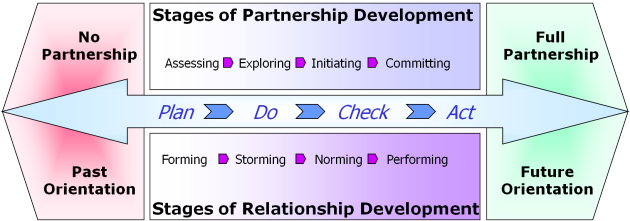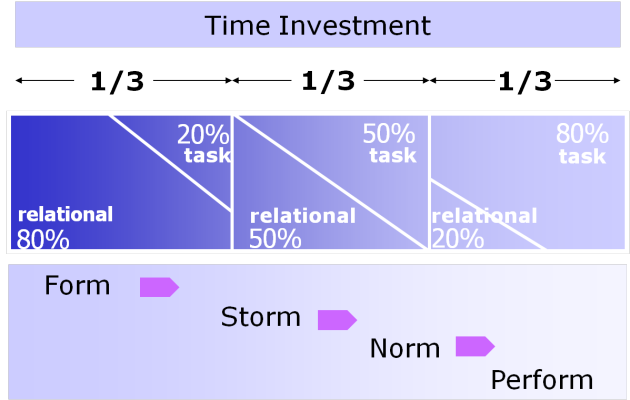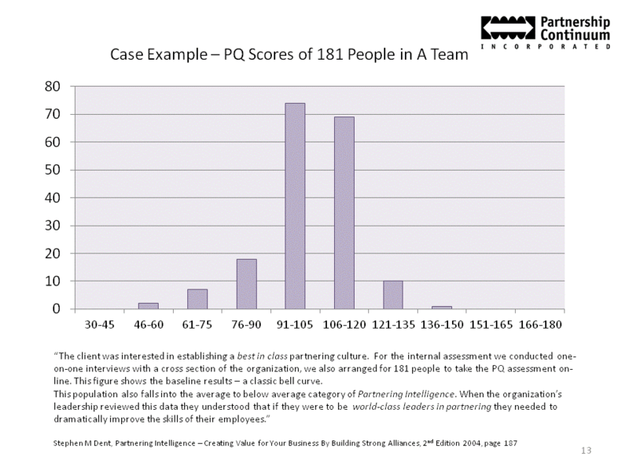
Partnership Continuum TM
In an increasingly challenging environment, business leaders recognise the need for strong and committed partnerships to deliver real competitive advantage. Creating successful business partnerships brings many benefits, for example:
- Expanding resource capability without major financial investment
- Improving performance, through enhancing customer relationships
- Reducing overhead expenditure by sharing facilities and resources, and
- Increasing organisational effectiveness with shared goals and values.
As with any relationship, a flourishing partnership needs to be worked at. The ability of an enterprise to succeed is described as its Partnering Intelligence. This is a measure of a team's ability to build and sustain healthy business relationships.
The Partnering Quotients (PQs) of team members are measurable – and unlike their IQ, the PQ can be improved significantly, with targeted investment and application. Effective partnerships can be built using The Partnership ContinuumTM partnering model – a blueprint for creating healthy, trusting. enduring and mutually beneficial alliances.
The Partnership ContinuumTM model is illustrated in Figure 1. It has two major components:
- Partnership development and
- Relationship development
Structured development in both of these areas leads to greatly enhanced performance, by changing the team's orientation from a past to a future one.
Six Attributes
Teams with a high Partnering Intelligence (PQ) establish and work on six major attributes that collectively help build enduring relationships:
- A future orientation - where the past is not used as a guide for decision making. Past failures may not be an indication of future outcomes. Equally that which worked in the past may not work in the future.
- A win/win orientation - Getting rid of the desire to win at another partner's expense. Embracing solutions that will have a positive outcome for both sides.
- An ability to trust each other and to be trustworthy.
- Increasing the level of comfort with change - recognising that while change is uncomfortable it may be good and needs to be managed.
- Being comfortable with interdependence, relying on another individual or company for support, assistance and success, moving to a consensus decision making style.
- Developing a willingness to be open with others, being comfortable with self-disclosure and feedback – this must be constructive.
Relationship development moves through four stages (see Figure 2):
- The forming stage needs time; partners have to learn to trust each other and clarify any issues to be resolved.
At the storming stage, group members test the limits of the relationship and learn to trust as they disclose their real needs.
The norming stage sees the group ready to collaborate to solve conflicts - to begin to take risks and explore new ideas.
Finally, at the performing stage, creative energies surface and the partnership can achieve goals that far exceed initial expectations.
There are two kinds of partnership – external and internal. External partnerships are best described as alliances between organizations. Internal partnerships are found within orgnizations and include the relationship between management and the workforce, or the co-operative relationships necessary between internal businesses, departments and functions.
Stages of Partnership Development
Partnership development is in four stages:
Assessing Stage
Assessing an organization's vision, ethics, values and culture (the ethereal realm) and its strategies, processes, products and services (its material realm)– gives an updated view of what the company is really about and where it is going. What is the vision for the future and is an external partner needed in order to achieve this?
If internal resources are available, the organization may simply need to work on their internal partnerships to better utilise those strengths. If appropriate resources are not available within the firm, the next step would be to seek out a compatible partner with the right skills and resources.
Exploring Stage
If an assessment has revealed an organization is ready for partnership, the next stage is exploring. The assessment team should seek out potential partners; ask questions about their visions, values, ethics and culture; look at the relationships and partnerships they may already have and how successful they are; identify what the organization can offer a potential partner. Once the right partner has been identified the next step is to secure commitments to work together.
The Initiating Stage
The purpose of the initiating stage is to create the right atmosphere of trust. It takes time to develop relationships; team building activities can help and key leadership will underline the importance of the exercise. The long term viability of a relationship can be assessed by agreeing to partner in a small way first – a ‘trial run’. Following a trial run three options are available: the partnership can be abandoned; partners may use the experience to revise, adjust and try again; there may be a decision to move to the committing stage and to make a greater investment in the partnership.
The Committing Stage
At this stage the partners need to agree their future goals and how they will achieve them together. Commitment to the partnership is reinforced by the sharing of information and resources. As full partners, each will be ready to invest in the success of the other, to their mutual benefit.
Designing A Powerhouse Partnering Cultur[...]
Adobe Acrobat document [598.7 KB]
Further Information
The Partnering Intelligence and Smart Partnering process has been developed in the United States by Stephen M Dent. Mr Dent is an award winning organisational consultant with a long and successful
track record with blue-chip clients. His book ‘Partnering Intelligence - Creating Value for Your Business by Building Strong Alliances’ (ISBN0891061919) is published by Davies-Black Publishing.
Partnership Continuum Inc and the ServQ Alliance deliver the process in the UK and Europe.



